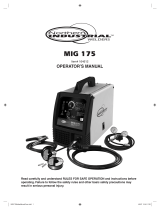
SERVICE, MAINTENANCE, TRANSPORTATION & STORAGE
The welder needs regular maintenance as following:
• Periodically clean dust, dirt, grease, etc. from your welder.
• Every six months, or as necessary, remove the cover panel from the welder and air-
blow any dust and dirt that may have accumulated inside the welder.
• Replace power cord, ground cable, ground clamp, or electrode assembly when
damaged or worn.
• Store in a clean dry facility free from corrosive gas, excess dust and high humidity.
Temperature range from 10°F-120°F and the relative humidity not more than 90%.
• When transporting or storing the welder after use, it is recommended to repack
the product as it was received for protection. (Cleaning is required before storage
and you must seal the plastic bag in the box for storage.
Maintenance and Service
• The PLASMA30 welder is a semi-automatic gas shielded welder. To properly
operate & maintain the welder can assure it of good performance and prolong
its operating life. Only the qualified personnel are allowed to be in charge of
repairing. It is strongly recommended customers contact with our company or
agent for technical, repairing, accessories supply and service back-up when they
feel unable to work out the technical hitch or problems.
• Maintenance job should be conducted by an authorised service agent.
• The newly installed welder or it not in use for some time needs to be surveyed
the insulation resistances between each winding and every winding to case with
multimeter, which cannot be less than 2.5MΩ.
• Keep from rain, snow and long-term exposing to sunlight when welder is used outdoor.
• If the welder is not in use either for a long time or temporarily, it should be kept
dry and have good ventilation to free it from moisture, eroded or toxic gas. The
tolerable temperature ranges from -20°C+55°C, and the relative humidity cannot
be more than 90%.
• Dust removal
• The professional maintenance personnel should use dry compressed air (use air
compressor or bellows) to remove the dust inside the machine. The part adhering
to grease must be cleaned with cloth while make sure there are no loosing parts
existed in the tightened places and connected cable. Usually, the machine
should be cleaned once a year if the dust accumulation problem is not very
serious, while it needs cleaning once or even twice every quarter if the dust
accumulation problem is serious.
• Regularly check the input & output cables of welder to guarantee they
are firmly connected.
• Regularly check the gas system, for any abnormal sound and for
any loose components.
• Keep torch cable direct when welding.























